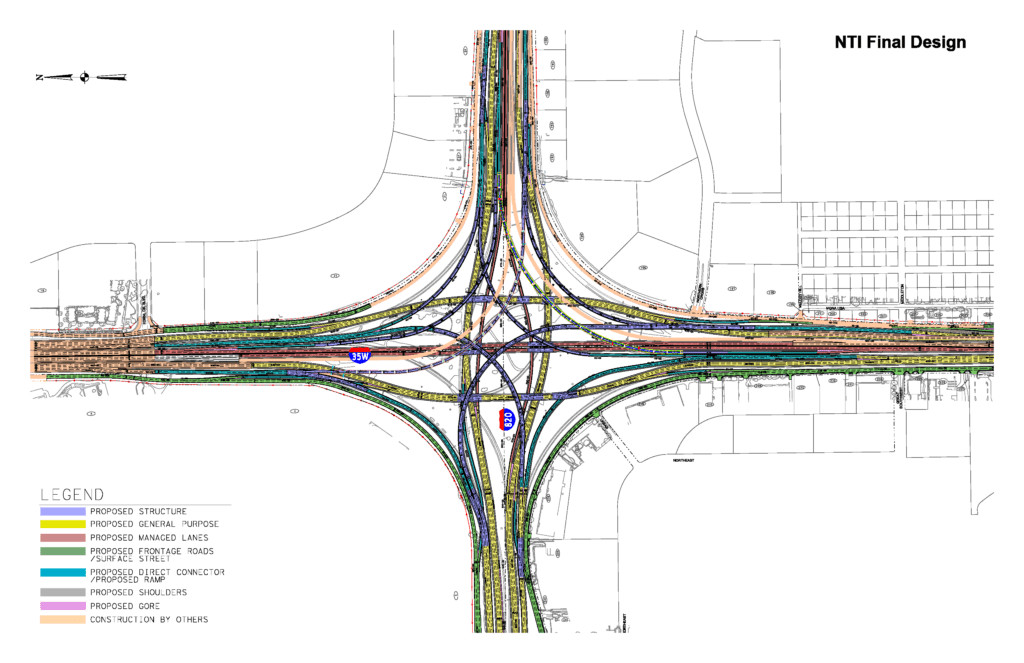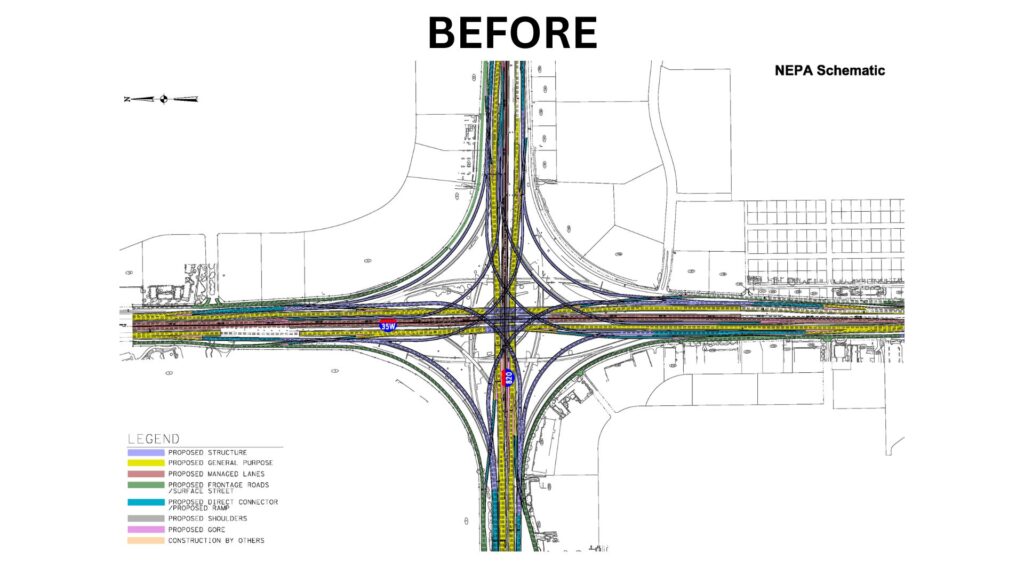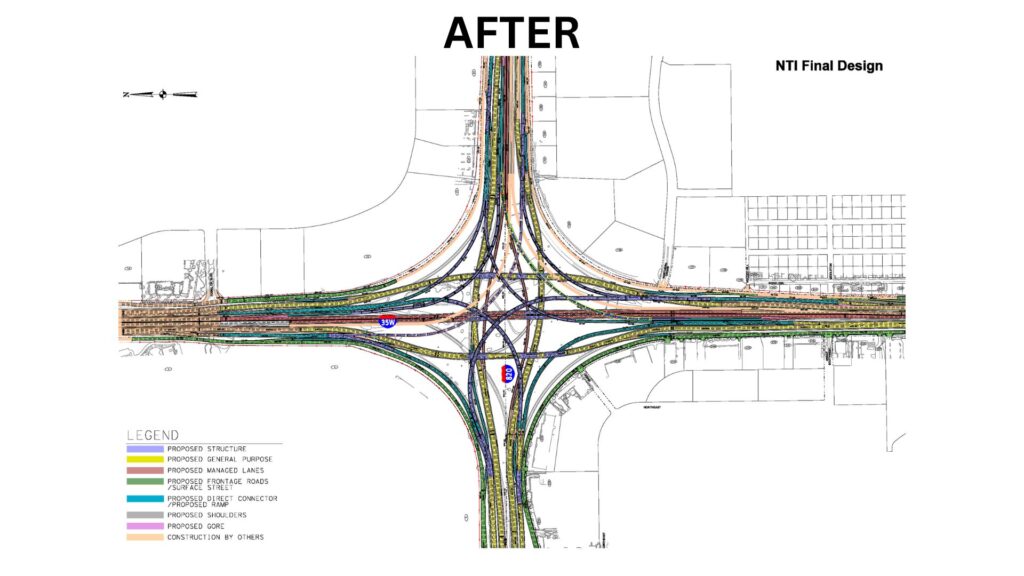Each project and asset is legally independent and has its own managers.
I-35 West/I-820 Interchange – Fort Worth, Texas
Ferrovial Construction U.S. has worked on expanding the I-35W/I-820 interchange in Fort Worth since 2009 under three separate construction contracts. These contracts added connectivity and capacity to the interchange by constructing the infrastructure necessary to introduce managed lanes and their respective access ramps. These actions took place under a Comprehensive Development Agreement (CDA), a concession contract that allows additional construction in response to traffic growth over the Concession life.
Our Strategy:
- Design solutions that incorporate room for future connectivity and/or capacity increases.
- Monitor congestion within the project limits and suggest capacity improvements in areas that would have become problematic if not addressed.
Initial Engineering Challenges
Due to financial constraints, the I-35W/I-820 interchange delivery was conceived in 2009 as a multi-stage construction process. Under the first construction contract, the business plan of the concessionaire only allowed for the construction of the managed lanes on I-820 plus the connection to these Managed Lanes from northbound and southbound I-35W General Purpose Lanes. This improvement in the interchange would generate an induced demand (demand “generated” by enhancements made to transportation infrastructure)and, in turn, be financially tapped (via tolls) to finance further improvements to this interchange. So, the challenge was to design the ramps and connectors of each construction contract, but with design and constructability considerations of the subsequent construction phases.
Contract 1: 2009 – 2014 (North Tarrant Express segments 1 & 2)
Work Scope
The first contract, as part of the CDA, was the design and construction of managed lanes (toll lanes) on North Tarrant Express (NTE) Segments 1-2W on the west side of the interchange (IC). The first action on the IC was to build the ramps connecting those managed lanes westbound from northbound and southbound I-35W.
Challenge
The primary challenge was leaving room for the ultimate configuration of the IC. You can see those future connections in the next contract.
Solution
Our engineers had to design the interim configuration under Contract 1 while also considering the design implications of the ultimate facility to be developed in posterior contracts. Considerations included leaving space for placement of future columns, drainage systems sized for ultimate configuration needs, and geometrical design that tried to minimize “disposable” infrastructure that wouldn’t have to be demolished in future contracts.

Contract 2 : 2012 – 2018 (NTE 3A)
Work Scope
The second contract covered reconstruction of all the necessary infrastructure to make room for seven new miles of managed lanes on I-35W. The project limits extended from the I-30 interchange to the south up to the I-820/I-35W interchange and connecting those managed lanes to the east and west to almost all directions [see figure 2].
Challenge
The design of this four-level interchange is highly complex because of the connections that would have to be built. Ferrovial Construction had to develop various alternative designs to gauge the maximum infrastructure that could be delivered from the ultimate configuration under a very constrained financial model. Construction under contract 2 had to minimize the “throw away” elements that would have to be demolished in future construction contracts.
Solution
To maximize the goal of improving connectivity and provide extra capacity, Ferrovial Construction modified the design after the Notice to Proceed was granted by TxDOT. Ferrovial Construction Engineering Services Department proposed spreading out the interchange to provide room for extending the managed lanes on I-820 to the west.
See figure 2, depicting the original design (labeled “before”) and the design providing greater connectivity and capacity for Contract 2 (labeled “after”). The revised design had the additional benefit of creating more room for accommodating future infrastructure than the original environmentally approved concept.
Before-and-After Construction:
- Yellow Vertical: Continuity is provided on the I-35W general purpose lanes (GPL), or free lanes, both north and southbound.
- Red Vertical: Managed lanes continuity is provided.
- Red Horizontal: Managed lanes extension to the west.
- Connections from managed lanes including West-North, West South.
- Connections in GPL including North-East, North-West, South-East, South-West, East-North, West-North, East-South, West-South.


Contract 3: 2018-2021 Interchange Improvement and 2018-2022 Mark IV
Work Scope
By 2017, the concession of the manage lanes for this project (construction Contract 1) was operating and revenues were higher than the original projections. The higher-than-expected traffic volume allowed the concessionaire to propose additional infrastructure from the ultimate capacity to be built much earlier than previous predictions through construction Contract 3. The scope of construction included (See Figure 4) :
- I-820 General Purpose Lanes eastbound to I-35W northbound managed lanes.
- Managed lanes I-820 southbound to westbound I-35W General Purpose Lanes.
- Improvement of Mark IV Parkway
- Southbound to westbound frontage road.
Challenges
The primary challenge for this third contract was finding a geometrical and structural solution to create additional connectivity to and from the I-35W managed lanes. Additionally, managing construction on top of what was already built in Construction Contract #2 would present a logistical challenge.
Solution
Ferrovial Construction engineers developed an innovative concept of generating extra revenue by adding additional connectivityto and from the general-purpose lanes and the managed lanes. The connectors designed by Ferrovial Construction included the I-820 eastbound GPLs to northbound I-35W managed lanes and the southbound I-35W managed lanes to I-820 westbound.
These two connectors were not included in the original environmental schematics. Therefore, this exercise was exciting since Construction Contract 2 did not accommodate the connectors mentioned above. Structural engineers and roadway engineers had a tough time configuring the northbound connector as it needed to take off from an existing (no more than two years old) general-purpose lane connector.
The southbound connector was challenging as well due to existing vertical clearance and column restrictions, and due to developer/TxDOT requirements, such as a right-side entrance to the general-purpose lanes on I-820 westbound instead of left-side entrance and allowing room for future extension of the managed lanes towards the west. The revenue projected from these two connections allowed for the financing of additional infrastructure listed below.
One of the most challenging parts of building this scope involved the interchange of Mark IV Parkway as the new infrastructure was overlapping the existing one. Numerous iterations needed to be developed to ensure that the construction happening in each stage would have enough space for the next phase.

